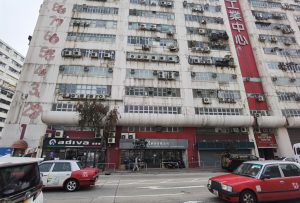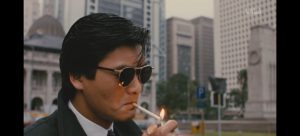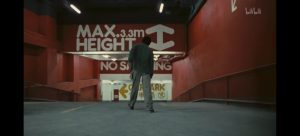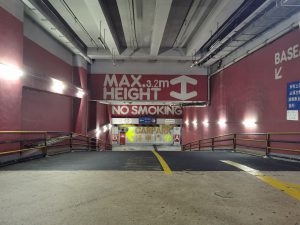Word file of my field report in the correct format
[ FIELDWORK] A BETTER TOMORROW, DIR. John Woo (1986)
Merit Industrial Centre, Kowloon, Hong Kong
The film A Better Tomorrow was released in 1986.[1] The film tells a story about a revenge story of two gangsters Sung Tse-Ho, Mark Lee and a policeman Sung Tse-Kit who was a younger brother of Sung Tse-Ho and hated him for their father’s death, showing the friendship and brotherhood. This story mainly took place in Hong Kong. The taxi company was the place Sung Tse- Ho worked in after he went out of prison and returned to Hong Kong. The Merit Industrial Centre was the place Mark Lee Worked after lost a leg when he killed a gangster in Tai Wan who helped arrest Sung Tse-Ho. The separated main characters met at the car park of Merit Industrial Centre, and Sung Tse-Ho found the true and destitute situation of Mark Lee. After being further bullied, they decided to take back what has been taken from them. In this site, the cruelty of Mark Lee’s situation and the warmth of the new life of Sung Tse-Ho coexisted.


Left: Taxi company where Sung Tse-Ho worked and was owned by Ken. Right: Now became an electric vehicle shop.
In the film, the building represents the new life of the two gangsters. For Sung, he had decided to retire from gangs and, due to his policeman brother’s hateful attitude towards him, decided to start a new life and be a good guy. Therefore, the Taxi company looks new and thriving. However, without a pair of healthy legs, Lee works in an underground car park that looks dusty and shabby. Coincidently, in reality, the two places are in the same building and are near each other. It is not sure whether the director arranged this on purpose or just for convenience, but this contrast situation does show us the solid friendship between the two characters. However, nowadays the taxi company no longer exists, but the Merit Industrial Centre is still there. The taxi company is now a shop selling electric vehicles, which, according to Robert Chi (2012), was an appearance on the disappearance.[2] Fewer residents in Hong Kong now choose the driving taxi way of living. What takes over is electric vehicles, which probably due to the thrive of delivery.


Left: Mark Lee used to be in high spirits. Right: After he was injured, he lived a life almost like a beggar.

The car park of past and now. It is almost the same.
Compared to the luxury cars and houses the two gangsters used to take and live in, the Taxi company and car park reflect the change of their lives. The feeling makes audiences feel unreconciled and want Sung Tse-Ho to make a change and revenge. When Lee was beaten cruelly by the betrayer, the will to revenge becomes more intense, and pushed Sung Tse-Ho to step out of the new life he wanted to live. Mark Lee’s loyalty to friendship was created through such a grieving plight his revenge for friend leads and his brave coming back on the last scene. The way the place presented helped to make this character more multidimensional and even the most popular among the three characters.[3] The Taxi company also serves as a shelter for the two characters and the backdrop for many events. The location of the building is also intriguing. Next to Kowloon City Ferry Terminal overlooking Hong Kong island, the place is far from the Central Police Station where Sung Tse-Kit worked. The separation of Kowloon and Hong Kong island represents the separation between the two brothers. When Ho was desperate and sat on bollards in many scenes, this location makes such behaviour reasonable. Additionally, the supporting role, company boss Ken who also appeared in the following episodes, was depicted through these multiple events and seems mysterious, making audiences curious about Ken and lay the foundation of his future appearance.
-Huang Xin, 3035771294
Note
1.A Better Tomorrow is a 1986Hong Kong action film directed by John Woo and starring Ti Lung, Leslie Cheung and Chow Yun-fat.
- Chi, R. (2012). Hong Kong Cinema Before 1980. In A Companion to Chinese Cinema (pp.75-94), edited by Zhang Yingjin. London: Blackwell Publishing.
- The film was Chow Yun-fat’s breakout role and launched him as one of the top superstars in the Hong Kong film industry. Chow’s character “Mark Gor” has been imitated by many fans even decades after the film’s release.
Clarify what you mean by appearance on the disappearance with regard to the shop selling electric cars replacing the taxi company. Did the taxi company actually exist in the first place or is it fictional and exists only in the film? Besides Chi, are you also considering this through Abbas twin notion of disappearance and appearance? You have made a number of meaningful points that will benefit from further clarification, especially the significance of the taxi company and car park and the choice of Merit Industrial Centre and its proximity to Kowloon City Ferry Terminal. Beside the geographical separation between the Kowloon peninsula and Hong Kong Island, how in particular does the camera capture the various scenes in which Ho sits on the bollards? An analysis of these scenes and a study or their similarities and/or differences especially in relation to the narrative would be useful as further reflection of your initial observations. As for Merit Industrial Centre, how are its different aspects and spaces framed and to what extent do these contribute to the unfolding of the narrative and the dramatic effects of the scene? A note on the writing: check for typos, grammar and syntactic expressions.